Inside a Traynor MkIII Chassis
"Tweed Reverb" Circuit in Action
Copyright (c) JC Maillet 2004
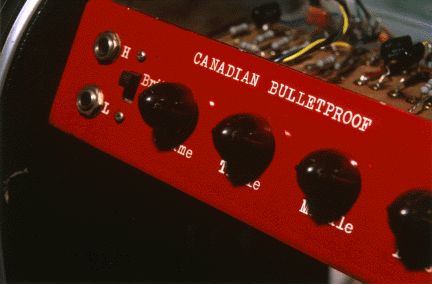 |
My first attempt at something personal, prototypish, boutiquish, whatever ...
The Traynor mkIII (YGL-3) is a great platform for trying out different circuit architectures ... since the mkIII has the same number of tubes as the Fender Blackface/Silverface Reverb amplifiers it can be used to house my "Tweed Reverb" circuitry ((c)'95) ... in this case though, the mkIII presents a Twin-like platform but it's designed to run on EL34's and is notably equipped with a huge Hammond output transformer - right off the bat this spells huge headroom if everything else is tweaked properly ...
The signal path that I use is a single-channel version of the '59 Fender Bassman/Twin cirucit with my direct coupled reverb hookup, a slightly Marshall-ized output stage and a Traynor-style bias modulating Tremolo circuit operating on the EL34's ...
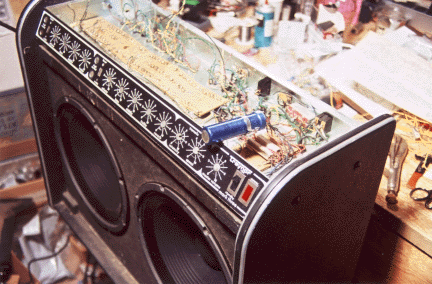 |
I wanted to try out some refinishing ideas on top of the electronics work ... after sanding off the original Traynor black lettering on the control panel buddy sprayed some Candy Appled Red nitro finish on it, then I slapped a quick letraset jobby on there, then buddy got it clear coated a couple of times ... worked out nice, the lettering stands out when light hits ...
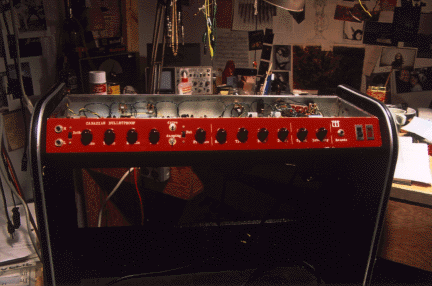 |
The Drive and Damp switch operate separate functions in the amp, one in the preamp and one in the output stage ... the "damping" function is based on an idea I learnt from Dave Vidal in Vancouver - in the way he mods the Blackface circuit to make it hotter, except in this case I'm applying it to the Tweed "Presence" control ... there are many ways of altering the gain-loop of the output stage ...
In the classic Tweed Bassman/Twin circuits (5F8-A and 5F6-A) the Presence control is a 5k pot normally - my trick here: I use a dual 5k pot with a dpdt switch which allows the shorting of the sweeper and top terminal of both pots (the ground lug is already common to both) ... what this does is it halves the return signal amplitude in th NFB loop which, in turn, opens up the output stage ...
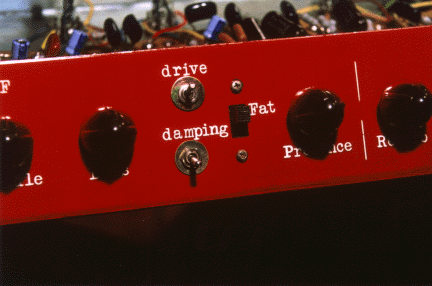 |
I often use the 2.5k-Presence pot setting at lower volume levels, the amp feels more lively and looser ... at times I prefer the loop "tighter" for higher playing levels (switched to stock 5k mode), other times not, at 2.5k the amp gets really dirty when cranked - the "Damping" switch gives the amp two different personality types ... Note: this arrangement doesn't achieve the same effect as a preamp boost function, it's different since it operates mainly on the dynamic characteristics of the output stage, not so much on its tonal aspects unless you count added harmonics as tone ... in other words, it's a way of increasing Pentode participation in the distortion picture fab ...
Aside from the independent Reverb and Vibrato features (see the Tweed-Reverb circuit description) this amplifier has a minimum of bells and whistles to it ... no effect loop or Master Volume control to compromise this signal path ... a trick I like to play on the Tweed/Marshall preamp is to give it more headroom than in the historically classic designs ... you do this by feeding the preamp section with higher supply voltage - and this is done in turn by reducing the series resistors in the filter networks - but be careful you don't go too low with those !! ... compare these values in other well-know amps to get an idea ... I used 1k/5w and a 2.2k/2w for preamp filter resistors in this amp - using these values in some amps will result in fried tubes ...
This increase in preamp headroom (worsened in Marshall's to make 'em more dirty) will change your perspective on the Tweed circuit if you've played an original Tweed Twin or Bassman ... I've done this increase headroom mod on my Marshall SL100 also (see my Marshall page) and it's very cool if you like that kind of old school power, it's like the one-drop-of-Vermouth Martini dryness ... an alternative that Ritchie Blackmore and Robin Trower were into ...
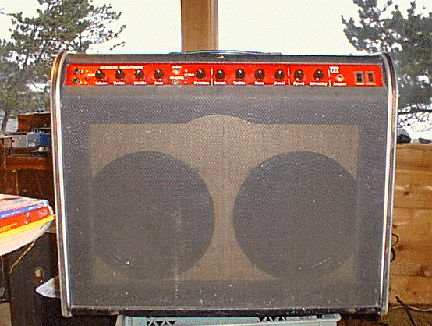 |
You may want to try this also on a dull sounding open-back cabinet ... I replaced the thumpy MDF soundboard of the mkIII with a 7-ply Baltic Birch plywood board (around 7/16" thick) ... it includes a thin gap between the soundboard and the cabinet on all four sides ... the board was mounted to the cab at four points using four short pieces of 2x4 screwed into the sides of the cab, then the sound board screwed into these blocks ... I cut straight slits partway down of each block on the in-side to make the board float a little ...
The properties of the Hammond Output Transformer gives the Tweed/Marshall circuit a slightly rounder edge in this chassis and the amp sounds a tad softer than a Marshall ... I do have to admit I didn't think the Hammond OT would sound that good ... we plugged a SM57 mirophone into it for singing at a jam and it sounded fantastic - clear just like Leo claimed his 5F6/8-A circuits did in his late 50's Fender advertisements ...
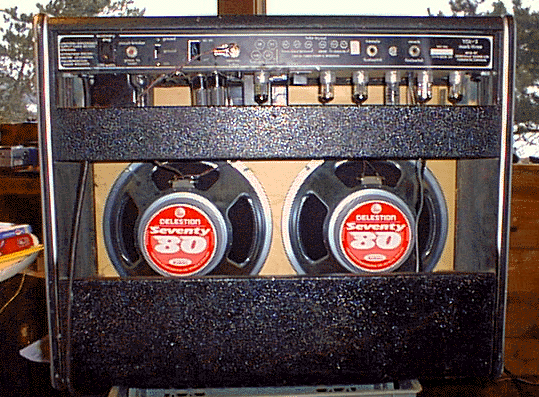 |
These Celestion speakers are made in China and to me they sound as good as other Celestion speakers I've tried ... I run my amp on only two power tubes (which makes the output stage even richer) so the amp is a very good match for the two speakers considering they are operating open back ... the amp puts out 55watts of clean power easily, and with the Celestions the sound remains clean, strong and penetrating even when I overdrive the amp where it puts out more power ... with all effects off this amp competes with any 50w Marshall for pristine attack and character, the Reverb and Tremolo functions brings that sound to the multi-channel amp class ...
viva Analog /// jc -> lynx.net






